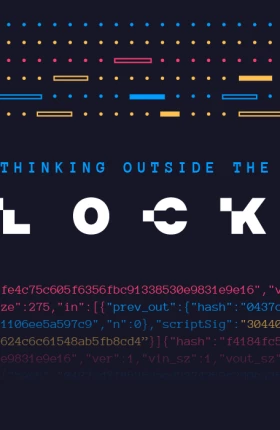This article is the result of a collaboration between BCG and the MIT Digital Currency Initiative (DCI), based at the MIT Media Lab.
Many new digital technologies at various stages of development hold promise for manufacturers and the supply chain. The challenge for management teams is knowing which technologies to invest in—and when. Case in point: blockchain technology. Once seemingly at the far end of the time horizon, blockchains are suddenly poised for rapid growth. Why? Because they offer a solution to the growing problem of how to manage increasingly complicated networks of manufacturers and suppliers at a time when transparency, speed, and agility are critical. In virtually every industry, complex ecosystems are emerging to produce our increasingly smart, connected products. These ecosystems are straining our traditional approaches to supply chain management (SCM). For instance, a typical automaker today is likely to work with about 30 partners and many more suppliers across multiple industries to produce the technologies, applications, platforms, and services needed for a smart car—and the lines between industries are blurring. Blockchain technology, which offers a more decentralized approach to data management and sharing, can improve the transparency, speed, and responsiveness of these complex ecosystems by the following means:
- Time-stamping, tracking, and automating transactions, so that events can be audited in real time
- Minimizing the involvement of intermediaries such as bankers, insurers, and brokers
- Setting up a wide range of self-executing contracts to automate repetitive processes such as billing and shipping
- Establishing proof of quality, provenance, payment, and performance to minimize counterfeiting and fraud
- Making it easier, faster, and cheaper to onboard new vendors and partners by assigning digital IDs
From a narrow operational standpoint, blockchains are not, in and of themselves, more efficient than centralized data systems. After all, they require additional computation power. But the technology is uniquely able to resolve important issues of trust and visibility in far-flung, increasingly fluid manufacturing and supply networks. It promises to be a game-changer for companies that need more agile supply chains to keep up with changing customer demands, or that are making the transition from market player to platform provider. The key is knowing whether and how to capitalize on a blockchain, when to combine it with other digital technologies for even greater synergies, and how to weigh its cost/value tradeoffs relative to those of other advanced SCM approaches, such as digital control towers. (See “Blockchains Versus Control Towers.”)
Blockchains Versus Control Towers
Blockchains Versus Control Towers
Blockchain technology and digital control towers both promise end-to-end supply chain visibility and the ability to automate task execution through smart contracts or algorithms. The decision to invest in a blockchain ultimately hinges on the importance and value of trust, and whether the benefits offset the resources required to set up a decentralized computing network—and the sacrifice of centralized control. Now that virtually every industry is seeing the emergence of large, complex, and fluid networks of manufacturers and suppliers, these issues of trust and decentralized control are growing in importance.
The matrix in the exhibit below can help companies weigh the tradeoffs of each technology. The sweet spot for a blockchain is the upper-right quadrant, where the value of both automation and trust are high. In these situations, a high volume of transactions makes the speed and efficiency of automation essential. At the same time, a large—and often changing—number of players means that a blockchain’s embedded trust features are worth investing in. When trust is critical but automation less so, a niche blockchain application can be the answer if the cost/value equation makes sense. When the speed and efficiency of automation are critical but trust is not an issue, control towers are the most cost-efficient choice.
Automating Trust and Control
Trust is an integral part of any highly functioning supply chain, and it usually develops over time as companies and suppliers work successfully together. When supply chain partners share data, financial information, and even intellectual property (IP), the trust they’ve developed in one another’s integrity and performance—along with contracts, audits, and other assurances—offset the risk. But in today’s complex manufacturing ecosystems, participants often don’t know one another; they lack visibility into each other’s data and activities. Trust must be built in some other way.
A blockchain’s checks and balances address that challenge. The technology provides a shared, trustworthy platform for updating information such as the financial strength of vendors, payment conditions, quality standards, pricing, delivery requirements, service specifications, and conflict resolution procedures. This information platform can make onboarding of new suppliers much faster and more efficient, with far less time spent on due diligence. A blockchain’s decentralized network of computers captures and time-stamps each transaction made by any member of the supply chain, recording it in a shared ledger that is continuously and collectively updated in real time. An algorithm ensures the validity of each transaction and prevents fraud.
Blocks of transactions are organized into an unbroken, ever-growing chain. The result is unquestioned data integrity—and a record that can’t be altered without consensus. (See “Is a Blockchain the Right Choice?”) Technology now in development will ensure that the data fed into the blockchain is valid and represents true supply chain activity.
Is a Blockchain the Right Choice?
Is a Blockchain the Right Choice?
The following checklist can help you determine whether blockchain technology is something your company should seriously consider. The checklist can also be used to explore whether the trust-based ecosystem enabled by blockchain technology can change current business models or create new ones.
- We need to record shared data, transactions, records, or contracts in a secure and permanent way, so that they are fully traceable and auditable. (A blockchain distributed ledger creates a permanent and tamperproof database.)
- Many parties need to add to or retrieve data or engage in contractual transactions. (Blockchains can grant different levels of access to different parties and facilitate data exchange.)
- We operate in a network of manufacturers and suppliers that don’t know or trust each other, and no central party exists that could establish trust—or it would be too costly to do so. (With relatively low setup cost, a blockchain can provide participants with secure transactions, trusted data, and self-executing contracts.)
- We operate in a complex value chain that deals with high-cost or mission-critical items. Assets change hands among parties, and the ability to prove identity or provenance is critical. (Blockchains can track assets along the value chain and throughout their life cycle to minimize the risk of counterfeit goods.)
- We act as an intermediary, connecting the transacting parties and establishing trust. (Your business model may be at risk of disruption with blockchain technology. Consider how to make a preemptive move.)
Work is also being done with enhanced encryption techniques to improve privacy and better protect competitive information while still providing proof of the integrity of the encrypted data. Broadly, these “zero-knowledge proof” solutions let people derive provably correct answers to certain questions from sets of encrypted data, without those people knowing the details of the underlying, plain-text information. One implementation, known as “auditable private logs,” has been developed by a team at the MIT Media Lab’s Digital Currency Initiative, led by its director, Neha Narula. One can imagine a supply chain network using such a tool to prove that a certain product is available, without revealing potentially price-sensitive information about the supplier’s overall inventory levels.
Blockchains can be public, public permissioned, or private. A public blockchain (Bitcoin, for example) is open, so that anyone with computing capacity can add to the network, maintain the ledger, and weigh in on issues requiring consensus. By contrast, public-permissioned and private blockchains are run by one or more businesses that have the ultimate say in all aspects of the platform, including who can join and which members can view or edit information in the digital ledger. Most industries are heading in this direction.
The decision to join a blockchain consortium or set up one’s own often comes down to strategic intent and relative market power. For a well-established global company, owning a blockchain platform can be a way to consolidate operations, create a marketplace, and change an industry’s competitive dynamics. Maersk had this in mind when it formed an alliance with IBM to make the ocean-shipping process more efficient. Using blockchain technology, the new system manages every aspect of the crucial document chain, ensuring that all the required information and approvals are at the right place at the right time, along with the actual shipment. The initial pilots of the system, which involved shipping flowers from Africa to Europe, sharply reduced the time and effort needed at every step of the way.
Although forming a consortium to run a blockchain is challenging to coordinate, this shared approach is the only way to unlock the technology’s full potential. Because power isn’t consolidated in a single company, governance tends to be more equally distributed, which goes a long way toward overcoming the trust barrier—and enhancing the sharing of information.
Smart Contracts
One aspect of blockchain technology that’s generating strong interest is its ability to create smart contracts—electronic agreements that self-execute according to predefined rules. By virtually guaranteeing the performance of often unknown suppliers, smart contracts allow companies to bypass conventional ways of establishing trust. Given the speed and ease of executing these contracts, companies could save substantial time and money. A wide range of supply chain transactions can be set up this way, including delivery of raw materials or finished goods, payment for value-added services, transfers of copyright or IP value, and insurance payouts. For instance, aerospace manufacturer Moog is looking to set up smart contracts with a range of suppliers, generating multiple purchase orders that detail the parts and components to be delivered, the price, and the delivery dates. Blockchain technology also allows companies to track the provenance of manufactured parts within their distributed supply chains.
The New York Shipping Exchange (NYSHEX) is testing blockchain technology and smart forward contracts to address price volatility, unused capacity, and a lack of transparency in the container shipping industry. The initiative is backed by major industry players, including General Electric, Maersk Line, CMA CGM, Hapag-Lloyd, and Goldman Sachs. The shippers that participate in NYSHEX’s blockchain platform will be able to view listings from carriers that have cargo space. Listing details include pricing, lanes, dates, and number of containers available. Once the shipper accepts a listing’s terms, the agreement becomes binding and is recorded as a contract, and the cargo space is removed from the exchange. Unlike in the spot market, where no party makes a financial commitment until the cargo is in the water, NYSHEX’s smart forward contracts require shippers and carriers to put up collateral worth up to 40% of the contract amount. Any party that doesn’t follow through forfeits that collateral.
Legislative efforts are already underway to establish the legitimacy of smart contracts. The US states of Arizona and Vermont have enacted laws that recognize blockchain contracts and digital signatures, making them admissible in court.
Industry Applications—Now and in the Future
Blockchains have exceptional potential in certain industries. In sectors with mission-critical applications—such as health care and the military—knowing the source of all parts, having information on product quality, and being able to pinpoint the supplier of a faulty component can save lives. In 2012, a US government investigation discovered $1 million in counterfeit parts intended for military helicopters. Fortunately, government protocol requires a paper trail for all parts and photographic proof of process authorization, so the source of the counterfeits was ultimately identified.
Blockchain can automate and accelerate this traceability. Moog, which makes precision parts for the US Department of Defense and the aerospace industry, is developing a blockchain platform to securely share computer-aided design specs of plane parts with suppliers and trace and audit the deployment and life cycle of each input.
Blockchains can also be valuable in industries where provenance is critical. In the food industry, for instance, a blockchain’s tracking function would speed up the ability of investigators to find and remove the source of food-borne disease outbreaks anywhere around the world, pinpointing particular crops or factories. In other situations, it’s important to prove that products are authentic, or that they were responsibly and ethically sourced. BCG and BCG Digital Ventures worked with De Beers to construct a blockchain for tracking diamonds throughout the supply chain. The result is a tamper-proof digital diamond register that streamlines manual processes, creates new efficiencies in the value chain, and provides consumers with further assurance that their diamonds are natural and responsibly sourced.
Looking forward, blockchain technology’s potential impact across industries is even greater when examined in a larger context. The convergence of technologies such as predictive analytics, machine learning, robotics, 3D printing, and the industrial internet is already transforming manufacturing and the supply chain. The greatest value will come into play when companies combine a blockchain with a mix of these technologies for greater power and synergy.
As we approach that more decentralized era—one of rapid production responsiveness in which a global array of potential actors will need to move in and out of supply chain relationships at short notice—the industry’s current preference for the permissioned blockchain model may be put to the test. A tendency among permissioned consortium members to block new entrants could limit the competitiveness of the overall chain.
Shifting to a “permissionless” system would create a much more open, dynamic model with fewer gatekeepers, advancing innovation and more rapidly leading to greater network efficiencies. But it would also be far more disruptive than the permissioned model, exposing legacy businesses to new competitors. The shift would require a leap of faith by existing supply chain members and a willingness to sacrifice some degree of control.
In addition, the technology behind more open, public platforms such as Bitcoin and Ethereum must be far more developed to meet the demands of the global trade system and its massive volume of transactions. Large, distributed teams of open-source developers are working hard to address these scaling challenges, and it’s reasonable to assume that they’ll come up with viable solutions. At that point, blockchain technology’s potential could explode. Just as the battle between intranets and the Internet—a battle that the latter won—led to a new era of business change and opportunity, we may be on the threshold of a similarly fertile period, ushered in by the current wave of blockchain innovation.
Now that digital technologies have removed the physical constraints on data transfer, trust may be the last major barrier to optimizing the flow of information that market economies thrive on. Blockchain technology’s ability to remove this barrier may allow us to finally unlock the real economic potential of our hyperconnected age. For supply chains, this could be revolutionary.
The MIT Media Lab transcends known boundaries and disciplines by actively promoting a unique, antidisciplinary culture that emboldens unconventional mixing and matching of seemingly disparate research areas. The Lab creates disruptive technologies that happen at the edges, pioneering such areas as wearable computing, tangible interfaces, and affective computing. The MIT Digital Currency Initiative (DCI), based at the Media Lab, brings together global experts in areas including cryptography, economics, privacy, and distributed systems to explore the many issues involved in cryptocurrencies and blockchain technology.






